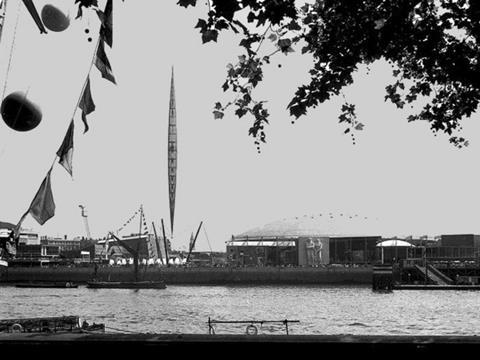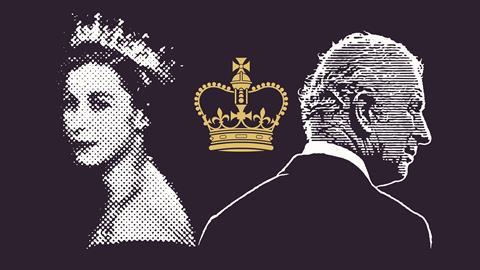The coronation of a new monarch is the perfect time to consider the future of our built environment, writes Ben Flatman
When, almost exactly 70 years ago, Elizabeth II was anointed as queen, in June 1953, it was of a nation still struggling to recover from the Second World War. London and several regional British cities were pockmarked by bomb damage, and many would continue to be so for years to come.
Amid the backdrop of wartime destruction and the austerity that still overshadowed many people’s lives, another Britain had begun to emerge. Perhaps the most visible evidence of the changes that were underway was the new architecture that was appearing.

The Festival of Britain in 1951 had set the stage for this new era, pointing towards a future of lightweight structures and high-tech wizardry. It made a significant and lasting impression on a whole generation of architects.
In the three and a half decades following the end of the war, Britain would build around 4.4 million council homes, at an average rate of 126,000 per year. This unprecedented building boom included new towns and universities, many of them designed by Britain’s leading architects.
It is not hard to understand why many people (particularly on the political left) look back fondly on this period as a time of huge optimism. It offered – and often delivered on – the promise of greater prosperity, equality and opportunity.
But there is another less widely discussed side to the first half of Elizabeth II’s reign that perhaps has had an even greater impact on our lives and the built environment. This was to be the era of the car.
Cars did not just blight local street life – they wrecked whole cities
In 1958 the Preston Bypass opened, the first stretch of “motorway” dual carriageway in the UK. It was followed in 1959 by the M1. Soon the Beeching cuts would be scything their way through the rail network.
As car ownership proliferated, streets and roads became increasingly dangerous. Deaths and injuries among drivers and pedestrians soared, peaking in the mid-1960s.
The idea of a street as a playground or place for social interaction was increasingly forgotten as almost all succumbed to their new role as endless linear carparks.
Cars did not just blight local street life – they wrecked whole cities. The powerful road building lobby and its willing accomplices in planning and traffic engineering were busy building massive new dual carriageways through the heart of urban areas. And architects happily picked up the jobs for remodelling the surrounding wastelands.
Cities like Glasgow and Birmingham destroyed and blighted large parts of their historic centres with Robert Moses-style urban motorways and ring roads. Although central London was largely spared, the Westway and Hammersmith flyover brought almost comparable levels of destruction to the capital.

Road widening and the need for ever more parking provided a useful excuse for demolishing more town centres to make way for multistorey carparks and what was often the banal commercial architecture of the period. Almost nowhere in the UK was able to escape entirely from the impact of the car.
The role of architects in all of this was complex. Some had happily ridden the wave of construction, willingly churning out whatever developers wanted, and planners were willing to approve – and pocketed the fees.
Others, perhaps, were more aware that what was happening in terms of the loss of historic fabric and traditional streetscapes was not only detrimental to townscapes but was damaging the reputation of architects more generally.
Architecture had not only become deeply implicated in what was widely seen as the poor-quality redevelopment of town and city centres, but also tarred by association with a lot of dismal social housing.
There is much good architecture from the 1960s and 70s that I love. But it is often hard, when flicking through a book on our historic cities, to argue with any conviction that many were improved by what was built during those decades.
In their hilarious and perhaps not entirely unfair satire, Monty Python famously portrayed architects presenting aghast clients with a design for a building that grinds its occupants into mince-meat. The scheme is rejected, in favour of one in which balconies collapse and the building catches fire (an alarmingly prescient vision of things to come, perhaps).
It was from within this context that the then Prince of Wales began to articulate his concerns
The gap between what architects considered beautiful and popular tastes had grown over time into a yawning chasm.
During the second half of Elizabeth’s reign, latent resistance began to develop into a more assertive rejection of what had been going on. Architectural conservationists and environmentalists bemoaned the massive destruction that had been wrought on both the built and natural environment.
It was from within this context that the then Prince of Wales began to articulate his concerns about the damage we were doing to natural habitats, as well as to our towns and cities. His famous “carbuncle speech” went down particularly badly among architects.
At the time he was widely derided as a “reactionary”, but if you read the speech today, it seems remarkably prescient.
As political and economic currents shifted towards neo-liberalism during the second half of Elizabeth’s reign, there began a truly reactionary movement, which included a ban on new council housing. The private rented housing market, which had all but died off during the early postwar era, made a ferocious comeback.
As we mark the coronation of Charles III, what changes can we hope for in the coming decades?
As the responsibility for delivering housing shifted overwhelmingly to the private sector, and mortgages were deregulated, Britain witnessed a rapid shift towards the financialisaton of housing. No longer primarily places to live, homes had become assets to be traded.
What was left of the country’s council house stock was often poorly managed and there was constant pressure on councils to sell it to tenants or to housing associations. An ideological belief in deregulation led to increasingly poor oversight of construction quality and safety.
The construction industry’s sorry descent into disjointed and unaccountable incompetence culminated in the horrific Grenfell Tower fire of 2017. Anything that could have gone wrong did. It represented everything that was wrong with Britain’s failed cut-price culture of prioritising short-term profits over human dignity.
As we mark the coronation of Charles III, what changes can we hope for in the coming decades? Here are a few suggestions:
- The UK’s population has changed massively since 1953. This year, for the first time ever, there will be a black president of the RIBA. We should see this as a stepping stone to greater representation and equality in the profession, and not an end point.
- Devolving power to combined authorities and elected mayors is a start, but they are still humiliatingly dependent on the scraps thrown from Whitehall’s table. A wholehearted change is required in how England is governed, with responsibility and accountability brought closer to its too-often-struggling regions.
- We face a slow-motion housing crisis, which has been in the making for the past four and a half decades. We must get all parts of government, the construction industry and planning system engaged in delivering a national plan for housing. A massive council house building programme should be at its core.
- The car will remain central to many people’s lives, but a tilt back towards walkable neighbourhoods and integrated transport networks (including new forms of personal transportation) could transform the way we live – improving physical and mental health outcomes, and enabling streets to become once again places for social interaction and play.
- The king’s well-known views on architecture are seen as divisive and hostile by many in the profession. But an intelligent engagement with discourses around the public’s attitudes to the built environment, and popular taste, could reinvigorate an architectural establishment that is too often insular and blind to its own failings.
- The UK is one of the most biodiversity-depleted countries in the world. Wildlife is in steep decline and struggling almost everywhere. Our rivers have become open sewers. Architects and the construction industry must redouble efforts to create a built environment that works harder to provide a home for plant and animal life.
- Charles III is a longstanding advocate for the retention and reuse of historic buildings. With the rise of interest in retrofit, here is an issue about which the king and the architectural profession can perhaps finally agree.
This new Carolean era could be one of repair and intelligent growth, but only if we are ready to make it so.
Also read >> Charles was mostly right. It’s a shame we architects couldn’t see it

















1 Readers' comment